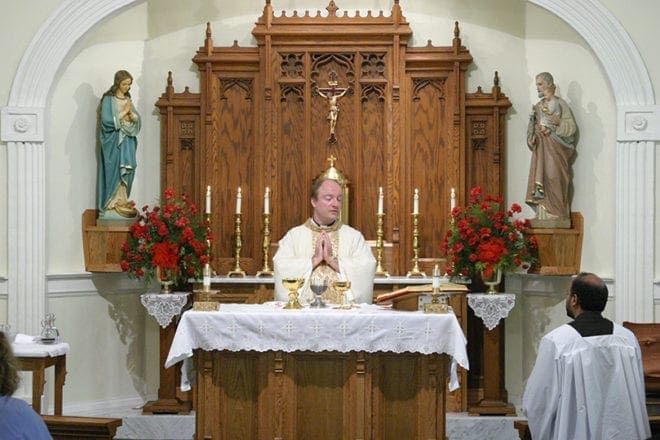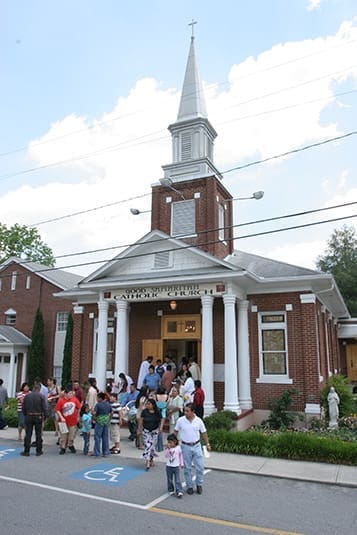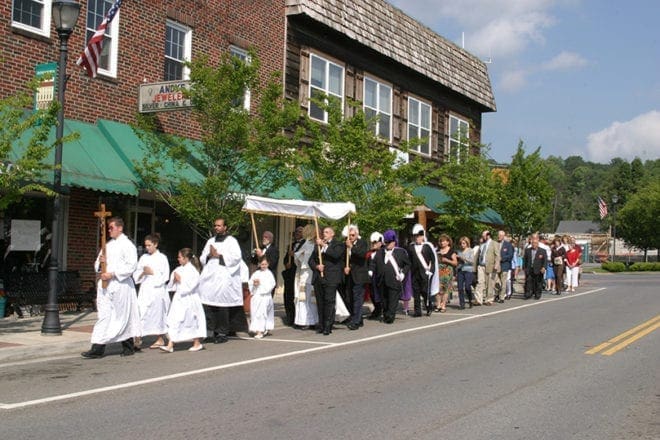 Photo By Michael Alexander
Photo By Michael AlexanderEllijay
Hope For Parish Bears Fruit In Apple Capital
By ANDREW NELSON, Staff Writer | Published July 17, 2008
One of the newest Catholic parishes in the Atlanta Archdiocese is adopting centuries-old church customs as its own in the Blue Ridge Mountains.
Leaving the red-columned Good Samaritan Church, the long line of parishioners was led by altar servers carrying a crucifix. The Knights of Columbus in plumed hats and swords added dignity to the procession. Following a tradition dating from the 1300s, Father Randy Mattox carried a monstrance with the Eucharist under a handmade canopy on the streets of this small city as the growing Catholic faith community marked the feast of Corpus Christi May 25.
The procession on this early Sunday morning, some 150 people strong, walked around the downtown neighborhood, past closed restaurants, antique stores and boutiques, singing hymns and the litany of the Eucharist.
“It’s important we don’t hide our faith. It’s a way to open dialogue,” said Father Mattox afterward.
The Good Samaritan faith community was elevated in January from a mission church to a parish, a sign of its vitality. Its growth illustrates how Catholics are moving into parts of the Peach State where Catholics have been few.
“We’re not playing second fiddle anymore,” said Jerry Landkamer, a leader in the parish.
The other Catholic mission turned parish in 2008 is St. Mary Church, located in Jackson.
Ellijay calls itself the Apple Capital of the state, with more than 600,000 bushels of apples grown. Two rivers, the Ellijay and Cartecay, snake together in the community to form the Coosawatee River. This county seat is some 80 miles north of Atlanta in rural Gilmer County, although newcomers are remaking the county from a tourist destination into a retiree haven.
The faithful here are shaping their parish. Its fall picnic is outgrowing its usual location. The large flea market draws people from around the county. Its ministries are reaching out to folks, especially the Hispanic people living here. On the spiritual side, the parish marked its new feast day this spring on Divine Mercy Sunday. And the Corpus Christi procession promises to become an annual tradition as it is expanded.
Long-timers say Mass was celebrated here beginning in the early 1980s. In 1986, Good Samaritan Mission started as an outreach of St. Anthony Church, Blue Ridge, a 20-minute drive down the mountain valley. At the time, Father Jorge Christancho drove here to serve the Catholics who gathered for prayer first in storefronts and then a funeral home.
Around this time, there were five Catholics for every 1,000 residents of Gilmer County, according to figures from the Association of Religion Data Archives that were collected by the Glenmary Research Center.

Good Samaritan pastor Father Randall Mattox stands before the altar during the Liturgy of the Eucharist. Kneeling to the right of the altar is seminarian Gaurav Shroff. Photo By Michael Alexander
In 2000, the most recent figure available, the number of Catholics jumped to 11 for every 1,000 residents. By comparison, the county’s biggest Christian denomination is the Southern Baptist Convention with 191 members for every 1,000 residents.
Looking ahead to 2015, church planners place Gilmer County as part of the circle of 49 counties surrounding Atlanta that are estimated to see moderate Catholic growth, probably gaining an additional 10,000 Catholics and creating a need to establish four new parishes.
About a dozen years ago, the Ellijay Catholics made a commitment to their faith. They were no longer satisfied worshiping in rented space. They wanted a church of their own. They ended up buying the 1926 Methodist church building for nearly $200,000 as that congregation itself looked to build a larger sanctuary.
The parish leaders came up with clever ways to repay the loan and to renovate the building. They shared for four years the sanctuary and social hall first with the Methodist congregation, as it built a new church, and later with a Lutheran congregation, said Michael Kirkpatrick, the broker that worked on the sale and a long-time parishioner.
One church prayed in the morning while the other group gathered later on Sunday. And the parking lot turned into a moneymaker as the church rented it out to a nearby business during the week, he said.
In all, thanks to the creative fundraising and the faithful digging deep into their wallets, the church mortgage was paid off early. And more recently, the community purchased and paid for a rectory, said Kirkpatrick.
In 2008, the faith community of close to 160 families officially could stand on its own as a parish. People now talk about the need to enlarge the 120-seat church building as more people show up for Masses, which are celebrated five times a weekend.
It is a church community so tight-knit adding Masses comes with a price. Becky Langas, a former member of St. Thomas Aquinas Church in Alpharetta and a retired schoolteacher at Our Lady of the Assumption, Atlanta, said more Masses means she doesn’t see the same folks worshipping together.

People depart from church following the 1p.m. Spanish Mass. The Gilmer County church, which once served as a mission of Saint Anthony’s Church, Blue Ridge, was elevated to a parish in December of 2007. Photo By Michael Alexander
“I feel like we’re missing something. It’s like missing a member of your family,” said Langas.
Father Mattox, 41, is the first pastor for Good Samaritan. It is also his first time being the spiritual leader of a Catholic community.
“What I love about it is everyone is very invested in the parish. Because it was a mission parish, they don’t take anything for granted. It’s a very can-do parish,” he said.
In the same spirit of the community, he too is venturing into new territory. He started a blog, “Days of Grace: Musings of a Catholic priest in north Georgia.” It is a challenge to write regularly, but he tries. Father Mattox described it as a “little experience of God’s grace in our lives.”
“I love it. Everyone is so loving. It’s a real sense of family,” said Father Mattox, who announced on his blog that he is starting a small hobby farm. First project is building a chicken coop.
Landkamer and his wife, Janet, moved here from Atlanta. They worshipped at Our Lady of the Assumption Church for 33 years before he retired as a manager at the Kroger grocery stores.
He said the parish reminded him of his small church growing up in rural Nebraska.
“It’s small. You know almost everybody. It’s a great community,” he said.
He was the first leader of the parish Knights of Columbus when the local group started in 2007. It started with 39 men and now there are more than 50.
As example of the can-do attitude here, pay attention to the church’s kneelers.
As a Protestant church, there wasn’t a need for any, Since kneeling is part of the ritual of Mass, when Catholics moved in that changed. Within six months, the Knights of Columbus completed a project that earned international acclaim.
The task was to construct 24 wooden kneelers. The challenge was the pews are curved.
Instead of costing $10,000, it ended up costing the parish nothing. The members of the group contributed the machine shop to make the brackets, another was a draftsman who knew how to shape the wood and others had the woodworking tools to put everything together.
The project was awarded the top prize from the Knights of Columbus on the state level. It won second place in an international competition by the fraternal organization.
The Catholic presence has grown here in part fueled by the Spanish-speakers who fill the church pews. About half of the church community is from Central America, particularly Guatemala and Mexico, according to parish leaders. In 2000, some 8 percent of the county population was Hispanic according to the U.S. Census Bureau.
Eladia Nieves is one of the leaders in the parish’s Hispanic ministry. She has served on the parish council and as a religious education teacher. Her first Communion class had 14 students, 10 of them Hispanic.

Led by crossbearer Nick Davis, the parishioners of Good Samaritan Church process down River Street during a May 25 Eucharistic procession on the feast of Corpus Christi following the 9 a.m. Mass. The procession, the church’s first, was organized by seminarian Gaurav Shroff, and it is expected to become an annual event. Photo By Michael Alexander
Part of her work with her husband, Ramon, is visiting newcomers in their homes. She hands out her phone number to anyone with questions. The people, who come from poor backgrounds, are Catholic, but are often encouraged to worship at Protestant churches that offer services in Spanish, said Nieves, 59, a Puerto Rican native who moved here seven years ago from Connecticut.
The Ellijay Catholic community is responding, she said. Father Mattox speaks Spanish, which is appreciated by people, she said. There are two positions on the parish council for representatives of the Hispanic community so they are involved, said Nieves, a mother of five.
“We have a beautiful community,” she said.
The community works to bridge cultural differences with bilingual Masses during special days, a fall parish picnic that includes a spread of food dishes representing the parish’s many cultures. The community decided to teach the religious education program in English because all the young people speak English or pick it up quickly, said Nieves.
With all the additions and growth in Ellijay, the heart of the community remains the people who sit in the pews.
Kirkpatrick, a 68-year-old real estate broker, has seen the community go from worshipping in a rented storefront to its own church, which is starting to feel cramped.
He talked about the time he looked at a local restaurant menu in the 1980s that said Catholics would not be served. Times have changed and the hateful message has been removed, he said.
The original band of 20 families that took up the challenge to purchase its own church is growing.
“We’ve got a unique little church. It was a family more than anything we had experienced before,” he said.